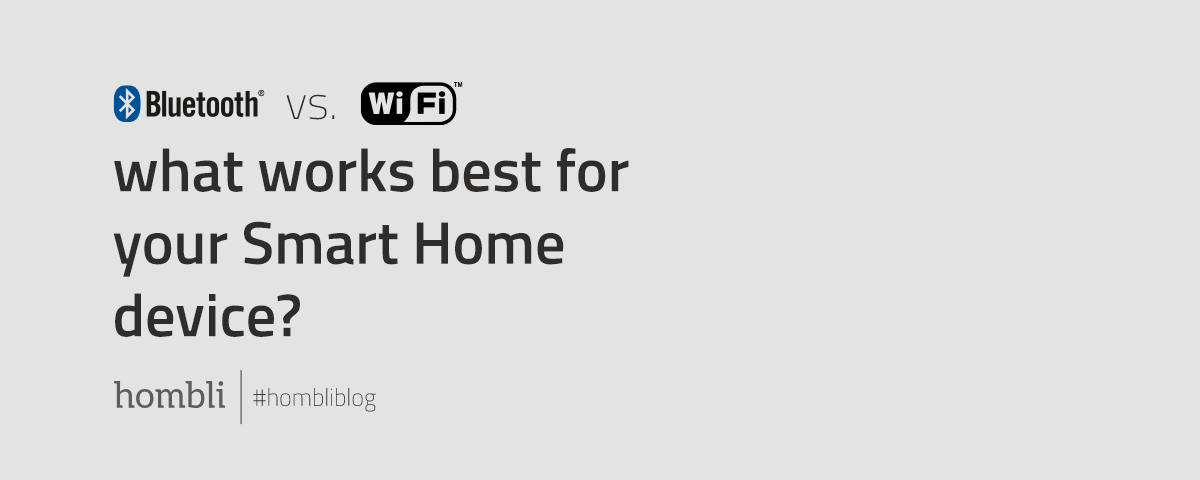
March 7, 2022
Bluetooth vs. WiFi: what works best for your Smart Home device?
When opening your Hombli app, you can turn your devices on and off, start your favorite smart scenarios or change the color of your smart bulbs. While it might seem like magic to some, it all comes down to communication, just like us as humans.
Comparable to individuals, all these smart devices can talk in different languages, mainly WiFi and Bluetooth. These are the languages, or ‘protocols’(as we call them), that our Hombli smart devices speak. Both protocols have different benefits, and in this blog article we explain why some smart devices use WiFi and others Bluetooth.
Always compatible with your smartphone
As aforementioned, there are many different protocols that smart devices can use to communicate, the most well-known are WiFi, Bluetooth, Zigbee and Z-wave. The reason why we chose for the first two is simple; every single smartphone, whether it’s an Android device or an iOS platform, are already able to communicate via these two protocols. We believe in a smart home for everyone, which means you can always control your smart home products directly out of the box, without any fuss.
A question that could arise is: why use WiFi for some products, and Bluetooth for others? Both protocols have their pros and cons, and we will dive into three different aspects and explain why either Bluetooth or WiFi is the best fit.
Heavier in data usage
When a Smart Motion Sensor detects movement, it sends a signal to your smartphone and notifies you. Sending this signal costs data, and while the Bluetooth protocol is able to handle the data that a sensor sends, Bluetooth would simply not be able to handle the amount of data our Smart Doorbell 2 would send to your smartphone. Not only does it send you a notification of detected movement, or the pressing of the button, it also needs to be able to show you direct live video footage that the camera captures.
You might remember sending videos to your friends on your phone via Bluetooth. Now compare that with watching a video on YouTube while connected to your home Wi-Fi network. One took ages, the other is instantaneous.
Control from outside of your home
If you are at home, within range of your smart devices, you can always connect via the Hombli app to control your smart home products. With WiFi this also works outside of your home, as long as you have an internet connection. However, if a device works with Bluetooth, you need to be in a certain range, which limits the location for control to the confines of your home.
Nevertheless, there is an option to control your Bluetooth devices outside of your house, even if you are relaxing on holiday, on the beach. If you connect these devices to a Smart Bluetooth Bridge, you will be able to use the Hombli app to control the devices no matter where you are, or even set Smart Scenarios to enhance your smart home experience.
Not wasting any batteries and faster too
While some smart home devices will receive their power directly from your homes electrical system, other smart home products are battery-powered. WiFi consumes a lot of energy, especially compared to the low energy version of Bluetooth. We understand you do not want to change the battery of your Smart Sensors repeatedly, as that would not only be frustrating, but it is also a huge waste of energy sources and money.
Moreover, devices like the Smart Sensor benefit from the low energy Bluetooth protocol, is that they can always be powered on. If a sensor would make use of WiFi, it would not be able to always be active, meaning, a signal can only be sent after the device has turned on the WiFi module. Lets say you connected your smart lights to the Smart Motion Sensor, every time you walk past the sensor it would take a few seconds until the lights would turn on, but with the power of low energy Bluetooth, this is instant.
It all depends on the situation
As demonstrated, WiFi can be more versatile than Bluetooth, as it can carry substantially more data and enables you to control it even outside of your home. However, it consumes more energy and for devices such as our Hombli Smart Sensors, that operate on batteries, the low energy Bluetooth protocol is more logical. Also, due to the low energy use of Bluetooth, some devices can always be turned on, and therefore react a lot faster to your movement or other triggers. With a Smart Bluetooth Bridge, we also ensure you can control or set up Smart Scenarios for your Bluetooth smart home devices, from outside of your home. One could say that it’s the best of both worlds.
Talking about Smart Scenarios, you can automate your Smart Sensors using the Smart Scenario feature in the Hombli app. Find out how you can get the most out of your Smart Sensors in our blogpost here or read our other articles.






